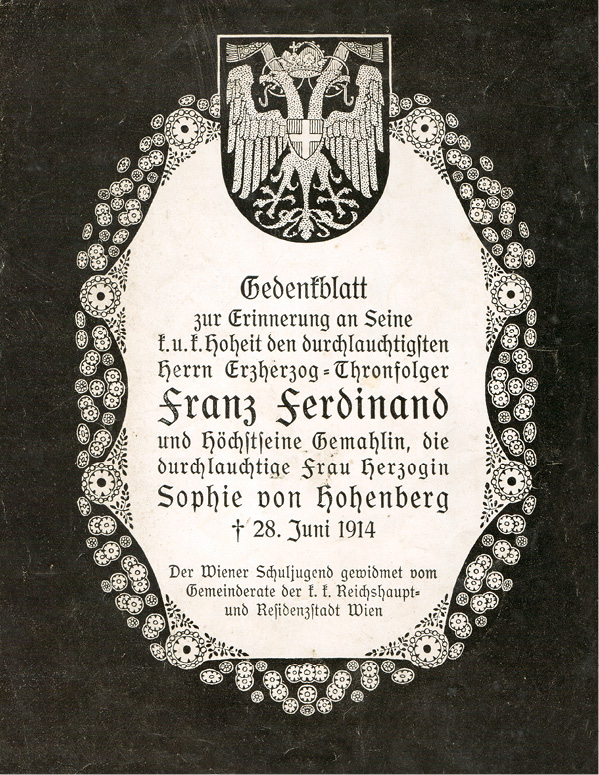1
Archduke Franz Ferdinand’s car
Country of origin: Austria-Hungary
Date of construction: 1911
Location: Heeresgeschicht-liches Museum, Vienna, Austria

IN 1914, THE world descended into a war that would see over 16 million people killed and would be fought on four continents. Yet, when war came, it was perhaps expected. Since the later part of the nineteenth century, the relationship between the most powerful nations of continental Europe—France and Germany—had been a difficult one. The Franco-Prussian War of 1870–71 had ended with France roundly beaten by the Prussians and had precipitated the end of the rule of Napoleon III and the proclamation of the Third Republic. With the termination of this war came the unification of the German states and the loss of the provinces of Alsace and Lorraine, a loss that would be viewed with great bitterness by the French. Elsewhere in Europe, old empires were crumbling and contracting.
In the Balkans, the complex ethnicity of the region led to tensions and the creation of the “Balkan Powder Keg” in the wake of the slowly crumbling integrities of the Hapsburg and Ottoman empires. The disintegration of these edifices had created new states—Serbia, Montenegro, Bulgaria, and Greece among them—each jockeying, aggressively, for position in the new world order. And it was the tension created by the Austro-Hungarian annexation of the former Ottoman province of Bosnia-Herzegovina in 1908 that created the tensions between Serbia and Austria-Hungary that would violently erupt into world war after the assassination of Archduke Franz Ferdinand, heir presumptive to the Austro-Hungarian imperial throne, in Sarajevo on June 28, 1914.
Franz Ferdinand was shot with his wife, Sophie, on the streets of Sarajevo while traveling in this 1911 Gräff and Stift Double Phaeton open car, today preserved in the Heeresgeschichtliches Museum in Vienna. Car manufacturers Gräff and Stift had been in business since 1904 and had made a name for themselves as the manufacturers of luxurious models; but with the killing of Franz Ferdinand, their most notable vehicle instantly became one of the most infamous in history. This impressive four-cylinder 32hp black car, the property of Lieutenant Colonel Count Franz von Harrach, the archduke’s bodyguard, had been deemed a suitable vehicle for members of the Hapsburg imperial family to be seen in. Today, it remains one of the most important artifacts of the war, representative of both the opulence of antebellum imperial Europe and the tragedy of the spark that ignited the powder keg of world conflict. Its single bullet hole, to the rear of the car, was the first of many bullets to be fired over the next four years. Yet the event could have been so very different.
With orders to travel to Bosnia at the command of Emperor Franz Josef, the archduke was to review the military maneuvers and visit the city of Sarajevo to open the State Museum with his wife, Sophie. Neither was to know that the “Black Hand,” a group committed to freeing Bosnia from Hapsburg rule and joining with Serbia, had targeted them for assassination. Arriving at Sarajevo on the morning of June 28, 1914, the royal couple transferred to the open-topped Double Phaeton car. Traveling as part of a motorcade of six, the third car was the archduke’s; the first car, due to a misunderstanding, was carrying the security officers. Only Colonel Harrach was there to secure the safety of the archduke and his wife. Inspecting the military barracks early on in the day, Franz Ferdinand was en route to the town hall when, at 10:10 a.m., the Black Hand threw a bomb at the car. It bounced off and rolled under the vehicle behind, disabling it and wounding its occupants. Severely shaken, the archduke and his wife went on to the town hall to attend a brief reception; after just over thirty minutes, they left to visit those wounded in the earlier attack. This proved to be a deadly mistake.
In a state of confusion, the driver of the archduke’s car took a wrong turn into Franz Josef Street. Reversing, he stalled the car. Gavrilo Princip, a nineteen-year-old member of the Black Hand, grasped his opportunity, firing his pistol twice. The first bullet mortally wounded Archduke Ferdinand in the jugular vein; the second hit Duchess Sophie in the stomach. As he was driven to the governor’s residence, and nearing the point of death, Franz Ferdinand’s thoughts were for his wife and children and for the perhaps millions of men who would be killed as a consequence. Princip was captured, tried, and sentenced to twenty years in prison. He died in captivity.
The assassin’s bullet became known as “the shot that was heard around the world.” Identifying Serbia with the actions of the Black Hand and bolstered by an expression of support from Germany, the Austro-Hungarians issued an ultimatum to their neighbor—a reminder of an earlier agreement between them to live with the Austrian annexation of Bosnia. The “July Ultimatum” required the Serbs to suppress all publications that “incite hatred and contempt of the Austro-Hungarian monarchy” and remove such materials from schoolbooks and public works. It demanded the removal from public office of all those deemed negative to the Hapsburgs. And it required direct action against the plotters and the acceptance of Austrian involvement in the investigations. On this last point, the Serbs, backed by their Russian allies, balked. War was to follow. The Austrians declared war against the Serbs at 11:00 a.m. on July 28, 1914. Another famous phrase, attributed to the British foreign minister Sir Edward Grey, aptly noted, “The lamps are going out all over Europe.”
